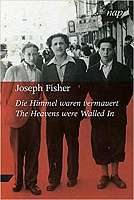The Jewish Prisoners of KZ Gusen II

After the disaster of Stalingrad the arms production of the Reich needed more hands and had to be sheltered. The main production centers in Germany and Austria soon got within reach of allied bombing in the beginning of 1944. Therefore the heads of the German armed forces wanted to put the production into subterranean areas.
Natural caves in Gusen were enlarged and the tunnels of a former beer brewery in St. Georgen, 3 km west from Gusen, were transformed into one of the largest subterranean production areas that ever existed. The deadly work was mainly done by Jewish men deported from Hungary to Auschwitz and by Polish Jews.
The first group came from Camp Mauthausen. 272 prisoners had to start the “Bergkristall” tunnel drilling and construction work. Further on, the transports of men were organised from Auschwitz via Mauthausen or to KZ Gusen II directly.
The local inhabitants remember the many young people, even children, running from the new constructed Camp Gusen II to the “Bergkristall” Tunnels in St. Georgen, driven by dogs and SS men mounted on horsebacks. Later platform trains were used to cover the distance and to transport the thousands of prisoners day and night. The local inhabitants also remember the icy winter of 1944/1945 when cattle trains from Auschwitz were posed outside the station stuffed with prisoners who could not enter the crowded camp and had to die after days of waiting in the trains.
The work inside the tunnels either at the drilling or at the production of jet planes is described as the most deadly work in heat and dust and under the steady threatening of death. Criminal Kapos used to beat and kill during work. As there was a lack of any security measurements many prisoners were killed by accidents and had to be carried back to the camp after the 12 hours work.
The exhausted figures called “Muselmen” usually died of starvation or of illnesses after three months. Jewish prisoners, forming the main group of Bergkristall accompanied by Italians, Polish, Russians, French, and some other nations suffered of the worst conditions. They got the smallest food or no food.
As the small crematory of KZ Gusen I could not do the work, many were transported back to Auschwitz just for gazation or to Hartheim, a castle near the Danube in Upper Austria, where handicapped inhabitants had been gassed and burnt before.
The utmost size of the camp was reached when Auschwitz itself had to be evacuated in January 1945 because of the approaching Soviets.
Many prisoners had to march to other camps or were transported in cattle cars even to Mauthausen and Gusen, filled with men, women and children. Many of them were killed immediately after their arrival by injections or gazation, others stayed in Gusen II like animals and were sent away from any food distributions and then died. Companions like Bernard Aldebert tell the worst sight they ever had: Jewish children, all naked, had to empty the latrines with buckets. They stood in the excrements up to their waists. There was just one water supply in Gusen II, and the water that could be used was taken from the Danube. Thousands got infected by typhus fever.
In April 1945 there were still by the thousands of prisoners in that primitive camp, but many had to return to Mauthausen and start the death marches to Ebensee and Gunskirchen according to the order “that no prisoners should get into allied hands”. Just a small number survived these long footmarches of 64 kilometres, and if they did, they starved in the days of liberation. Jewish prisoners were the least ones to have the chance of surviving.
Rav Yechezkel Harfenes, a survivor of several Nazi camps wrote: “Compared with these all cruel camps I can say these were paradises compared with Gusen. It is unknown as there were just a few survivors of many tenthousands who can tell the story of its horrors.”
To learn more about the Situation of Jewish Inmates in KZ Gusen II, the Gusen Memorial Committee supported the publication of the following recommended books:
- Bernard Aldebert, Elisabeth Hölzl (Ed.), Gusen II – Leidensweg in 50 Stationen (Chemin de Croix en 50 Stations) (1997)
- Joseph Fisher, David Fisher, Gerhard Führer (Ed.), The Heavens were Walled In (2017)
- Karl Littner, Rudolf A. Haunschmied (Ed.), Life Hanging on a Spider Web – From Auschwitz-Zasole to Gusen II (2011)
#RememberGusen